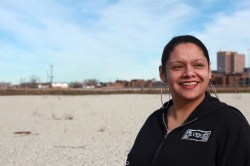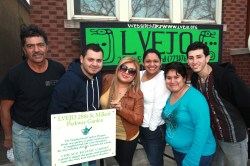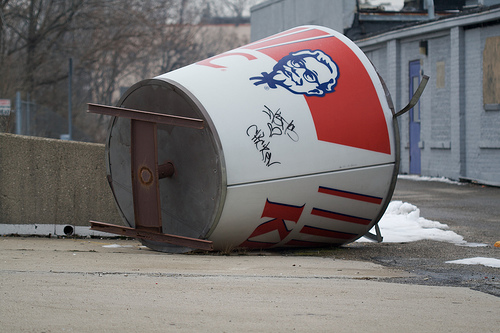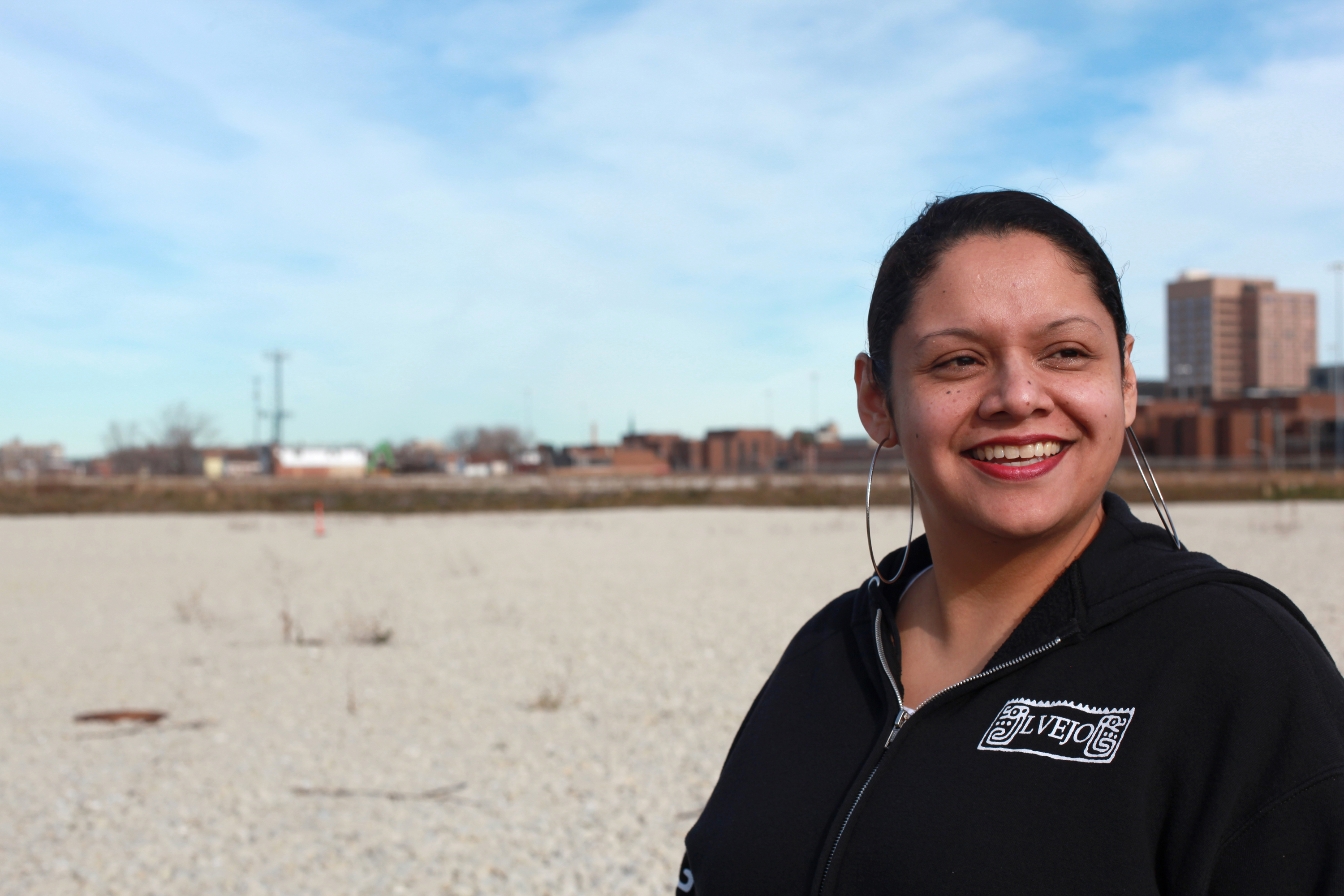
Kimberly Wasserman.
Last summer, clean-air activists celebrated the shutdown of Chicago’s notorious Fisk and Crawford coal power plants, which ended the Windy City’s distinction as the only U.S. metropolis to house two operating coal facilities. The victory came thanks to a dogged grassroots battle waged by residents of Little Village and Pilsen, the predominantly Latino, working-class neighborhoods bearing the brunt of the plants’ pollution. Today, the woman who spearheaded that battle, lifelong Little Village resident Kimberly Wasserman, becomes North America’s recipient of the Goldman Environmental Prize, one of the highest honors in the world for grassroots green activism.
Wasserman was 21 when her infant son suffered his first asthma attack. She had just started working for the Little Village Environmental Justice Organization (LVEJO), doing door-to-door surveys gauging neighbors’ environmental concerns, so she started asking around about asthma and respiratory issues, which turned out to be common problems in the community. Soon after, a Harvard School of Public Health study confirmed LVEJO’s suspicions that the coal plants might have something to do with the high rates of asthma in the neighborhood, and Wasserman started organizing.
We got a chance to talk with Wasserman about what it took to kick Big Coal to the curb.
Q. Tell me about what motivated you to take on this issue. How long had you lived in Little Village, and how aware were you of environmental health issues before?
A. I was born and raised in Little Village. I’ve lived here 32 out of the 36 years that I’ve been on this lovely planet. I didn’t know a whole lot about air quality or environmental issues before entering this job [at LVEJO]. [When] my baby was about two months old, he had his first asthma attack. I started focusing my door-to-door conversations to try to understand how many other people had family members with respiratory issues. We found that an alarming number of people in our neighborhood had asthma. So we started to look at, what is in our neighborhood? We found the coal power plants. A lot of folks didn’t know what they did there; the smoke was white and very unassuming, and so a lot of young people called it the cloud factory because they thought that’s where clouds came from.
It made us want to understand, well, how do you burn coal? The more we researched, we were surprised that our local government would allow such dirty and outdated technology. In 2000, Harvard School of Public Health released a study about coal power plants in Illinois, and the information about the Crawford and Fisk plant[s] was very astounding. There were over 3,000 asthma attacks, 1,500 emergency room visits, and 41 deaths a year attributed to these coal power plants. And then on top of that, we found out the coal power plant didn’t supply electricity to the city of Chicago or the state of Illinois.
Q. How did you share what you’d found out with the neighborhood and organize people to fight for change?
A. We shared this door-to-door. We had block meetings in which we would talk about what is asthma and how do you develop it and what are some of the contributing factors. [People aren’t] just dealing with a child or an adult or a senior with illness, they’re also having to miss work, people are missing school, and all those [things] have an impact on the community. People were upset when they found out that the city wasn’t willing to do anything about it. Why is it that our community is being sacrificed for the sake of making money for this industry? It was on us to make sure that we funneled that anger and resentment in a positive way.
At first we sent a letter to city hall and requested a meeting, and nobody wanted to talk to us. Our young people wanted to show what this meant in real life. So they did an action on the fifth floor of city hall, in front of former Mayor Daley’s office. Forty-one young people laid on the floor and zipped themselves up in body bags and put inhalers in their mouths. We got a phone call from the mayor’s media office that basically yelled at me and said, you embarrassed the mayor, this is not appropriate. And our response was, well, this coal power plant in our neighborhood is not appropriate. So we knew that we struck a chord.
Q. How did the culture and sense of community in Little Village contribute to your campaign?

Members of the Little Village Environmental Justice Organization.
A. A lot of what helped us was looking at the history of where our people come from. Taking the lessons we learned from both Mexican and Mexican-American history, and looking at movement building and murals and art and street theater, and how all of those things played into communication of a struggle and a solution — we tried to incorporate posters and art and murals. We did street theater; we held clean-power elections where we would have folks on one corner with wind and solar power, and on the other corner we had coal barons dressed to the nines in tuxedos. It helped us educate people in nontraditional ways, but ways that have been shown in our history and culture to be very effective.
Q. What was the turning point that led to your eventual success?
A. In creation of the [clean power coalition, a partnership with big green groups], we were able to leverage a lot of resources that organizations like ours don’t have. Greenpeace scaled the smokestack in Pilsen and camped there for two days, which is amazing because our community members are like, I can’t afford to get arrested, I have no papers.
The second thing was that Mayor Daley announced that he was retiring and would not be seeking reelection. The opportunity to make this part of the election campaign was instrumental. Every time there was a debate or an interview, we tried our best to get this issue included in that conversation. So when Rahm Emanuel won, we were able to hold him to his promise of saying if I win, I’m going to deal with the issue. A year into office he was like, all right, you guys have garnered enough support. He let [the coal plants] know what was happening and gave them 90 days [to either comply with required upgrades and lower their emissions or shut down]. Ninety days later they came back and said we’re going to voluntarily shut down.
Q. Mainstream green groups like the Sierra Club often get criticized for not working well with grassroots organizations. Why do you think that is? What was your experience building the clean power coalition?
A. Unfortunately I think a lot of it has to do with money and power. [Environmental justice] organizations get less than 5 percent of environmental funding out there. There has to be pushback on that, but there also has to be a conversation. When we came together as a coalition, one of the first things we did was have a conversation on power, on race, on class. It’s the communities of color that are being impacted [by climate change and pollution]. We created a memorandum of understanding to make sure that we as smaller organizations weren’t thrown under the bus, that we weren’t excluded from negotiations.
Luckily, both the Illinois chapter of the Sierra Club and the local Greenpeace office were willing to [agree]. I think the staff they have are young people who understand the privilege they come from and are willing to humble themselves enough to have these difficult conversations and find authentic ways to work together. That’s the reality of doing this work — you have to have these uncomfortable conversations.
Q. What are you tackling next, now that the coal plants have been shut down?
A. We have brownfield legacies in our community, and we don’t want another one. We don’t want to be looking at an abandoned coal power plant for the next 20 years. So we’re looking at the remediation and redevelopment of that.
While we were struggling to shut down the coal power plant for 12 years, we were also advocating for a new park to be built in our community. We won that victory as well last year. We’ve been working with the community to develop a design for the park, and make sure that adequate funding is given to this park, being that it’s going to be the first one built in our neighborhood in over 75 years.
And then the last thing that we’re working on is our public transit campaign. We find ourselves in a public-transit desert in our neighborhood. You have to go about a mile north to get the train; it used to go three miles south before you could find a bus. Last year, we won the installation of a new bus line in our neighborhood, so now we have a bus smack-dab in the middle of that three-mile gap. They only gave us a third of the full route we wanted, so we’re going to be advocating for the rest of the route until we get it.
Q. What’s your advice for other communities facing similar battles?
A. Definitely don’t give up. And definitely arm yourself with as much research as possible. There is tons of capacity in our communities to do research, to do surveys, to collect and analyze data. We have to be arming our young people to be thinking about careers in math and science and engineering to be able to bring those skills back and help us tackle some of these environmental-justice issues. When our campaign started, some of our young people were in first or second grade, and those young people are now in college, getting their masters in environmental justice, because this had such a resonating effect on them.
—
Watch a video about Wasserman below, and read more about this year’s other Goldman winners here.



